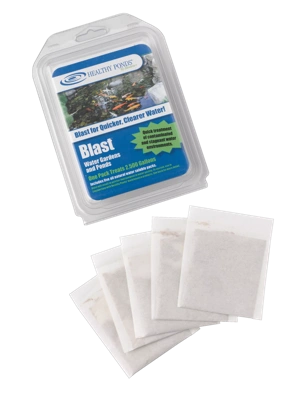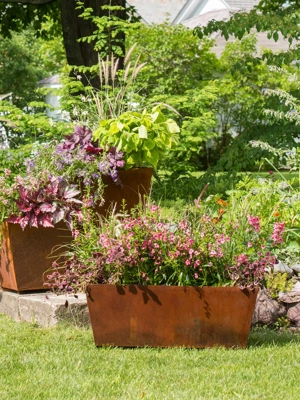Gardening With Water Features
Finding the Site, Choosing Plants and Fish
 A water garden can be an elaborate planting in and around a pond, or something simple in a watertight container.
A water garden can be an elaborate planting in and around a pond, or something simple in a watertight container.A water garden opens up a new world of planting and landscaping possibilities. You can start small, with a hollowed-out stone that catches rainwater, a watertight, patio-sized container or jump right in with an in-ground pond with water lilies, fish and a fountain.
Before building your water garden, do a little homework to decide what size and design is best for you. Unlike regular gardening, where you can blunder your way through almost any experiment and start fresh the following year, a pond often involves a greater investment of time and money. A smaller water garden in a container may be a better fit for your lifestyle and wallet that doesn't sacrifice the soothing beauty and color of water plants.
Siting and Design
If you wish to build an in-ground pond, consult an experienced local contractor or research the options and requirements thoroughly before beginning. Mistakes and poor planning can be costly. Here's an overview of what's involved in building a pond.
A natural-looking water garden should have sloped sides with planting terraces that step down toward the deepest area of the pond. This allows you to plant a diversity of plant material and create different habitats. In northern areas, a depth of 24 to 36 inches is usually necessary to ensure that the pond will not freeze solid during the winter.
If you live in a warm climate, where frost heaving is not a problem, you can line the bottom of your pond with concrete, brick or even clay. Today, most gardeners and professional landscapers use a preformed liner made from fiberglass or plastic, or a flexible, cut-to-fit liner made from PVC or butyl rubber. The preformed liners are quicker to install, but the flexible liners allow for much greater creativity.
Where to Put a Pond
- Place in a location that receives at least 5 hours of sunlight a day.
- Avoid low spots or areas that accumulate runoff.
- Don't put the garden under large trees.
- Find a level spot.
- Provide easy access to electrical power and fresh water.
Consider Containers
For something on a smaller, more manageable scale, consider a patio water garden. Many water plants can be grown in a tub of water on your deck, and you can even add fish or a fountain. Use an ordinary whiskey barrel lined with plastic, or purchase a plastic tub that is specially designed for a water garden. Miniature water lilies, lotus and many other water plants grow beautifully in as little as 20 to 30 gallons of water.. Place your container where it will receive at least 6 hours of sun a day for best plant growth and flowering. In hot climates, containers do best with afternoon shade.
The Plants
Water gardens should include floating plants, submerged plants and edge plants. Some water plants are invasive, however, and should only be grown in containers. Reputable garden centers and on-line sources will sell only approved plants in your State. Check with your State's Natural Resources Agency for a list of banned water plants, if you have questions. At the end of the growing season, discard water plants in your compost and never place them in lakes, rivers or streams. Floating plants shade the water and absorb dissolved nutrients. By doing so, they help to suppress algae and keep the pond clean. A few of the many examples of floating plants include duckweed, American frogbit, water hyacinth, water lettuce and water lilies.
Hardy water lilies are available in an array of colors from white through yellow, pink and red. Many bloom from late spring until frost and will survive the winter in deep ponds as far north as USDA zone 4, as long as their roots don't freeze solid. Plant them in sturdy containers that can be submerged 10 to 18 inches deep. Otherwise, remove the pots from the water in late fall, place in a bucket of water, and store in a protected, non-freezing area over the winter. For container water gardens, choose a miniature variety that will spread only two to four square feet.
Tropical water lilies look similar to the hardy varieties, but the blooms are larger and held several inches above the water. Many are also fragrant. Tropicals are hardy only to Zones 9-10, and can bloom year-round in warm climates. They will not flower, however, unless they are grown in full sun and have water temperatures above 70 degrees F. Some are day-bloomers and some are night-bloomers. Night-bloomers are best for viewing during the evening and early morning when most people are at home. Miniature varieties are available for patio tubs, too.
Lotuses are another beautiful choice, though they are not true floating plants as they usually hold their leaves and flowers 1 to 8 feet above the water surface, depending on the variety. Each lotus blossom can be as much as 10 to 12 inches across, although miniature varieties are much smaller. After blooming, lotus flowers leave behind a large and distinctive seedpod. They are generally hardy to USDA zone 4 or 5, if their roots are not allowed to freeze. Plant them in wide, sturdy containers without holes that can be submerged 10 to 18 inches deep. Otherwise, remove the pots from the water in late fall and store in buckets in a protected area over the winter. Take care in handling, as their growing tips are very delicate and can be damaged easily.
To bloom abundantly, water lilies and lotus grown in pots must be fertilized throughout the growing season. Insert water plant fertilizer tablets into the soil near the roots once a month, following the package instructions. Plants grown directly in the mud at the bottom of ponds do not need fertilizer.
Submerged plants spend their entire lives growing beneath the surface of the water. They are usually called oxygenators. They obtain their nutrients from the water directly through their stems and leaves and do not require soil or special fertilizer. By absorbing nutrients, they compete with algae and help keep your water clear by consuming dissolved nutrients. Submerged plants also provide a spawning area and hiding place for fish and other water creatures. Common submerged plants include: anacharis, hornwort, cabomba, hairgrass and sagittaria.
Edge plants grow on a "shelf" 5-to-10 inches below the surface of the water or in the moist soil next to the pond, providing shelter for fish, frogs and other plant life. Shelf plants include sweet flag, canna, water plantain, marsh marigold, pickerel rush, sedges, cattails and arrowhead.
Plants that thrive in the moist soil next to a pond include filipendula, Japanese and Siberian irises, trollius, liatris and ajuga.
Adding Fish
Fish can be a fun addition to a water garden and help keep the mosquito population in check. Plus, their wastes are a good source of nutrients for plants. It's important to balance the number and size of the fish with the size of the water garden. Too many fish means too many nutrients and that leads to algae blooms. Fish also require plenty of oxygen. Warm water contains less oxygen than cool water, so a 30-gallon tub on a sunny patio can hold fewer fish per gallon than an in-ground pond. In warmer patio tubs, try tropical fish, such as guppies, instead of cool-water goldfish. As a general rule you should have no more than one goldfish per 3 square feet of surface area of pond or one guppy per gallon in a tub. (With an active filtration and aeration system, the number can be much higher.)
Most native fish, goldfish and koi can survive the winter in a deep pond if the water doesn't freeze to the bottom. Keep a hole open in the ice with a bubbler or heater to allow oxygen exchange. Fish kept in shallow ponds and containers will need to be kept indoors for the winter. Never release them into rivers, ponds or lakes, which is inhumane and illegal.
Koi are large, long-lived, colorful fish popular in Japan. Koi require cool, or highly oxygenated water, which means your pond needs a filter and/or an oxygenating fountain. They are not suitable for containers. Koi must be fed at least several times a week. They tend to dig extensively and eat water plants (especially expensive water lilies).
Goldfish are a better choice for ponds, where permitted. Although they can grow up to a foot long, they are less destructive and usually do not eat plants. Note that keeping goldfish and koi in outdoor ponds is not legal in all states.
Once your new pond has settled in, birds, frogs, toads, snails and water insects, such as water striders and dragonflies, will begin to appear. Each of these creatures will settle into its preferred habitat, helping to complete the ecosystem. Some of these creatures, such as frogs, herons, raccoons and dragonfly larvae, will eat fish, however, even in small patio tubs. Observe your water garden closely and take precautions to exclude them, if desired. Netting is effective, especially over small ponds and containers.
Most water gardens do not need a filtration or aeration system. To maintain the best water quality, add the right mix of water plants, remove dead or dying plant matter regularly and tolerate water that isn't crystal clear. Green water (suspended algae) and hair algae (long green strands)are common early in the season until other water plants outcompete them for nutrients and sun. Barley products can help with algae control. If your pond is stocked with fish, especially koi or other cool-water species, however, you may need a filtration or aeration system to help clean and oxygenate the water.
Learn about the science behind water quality, and be attentive to what is going on in your ecosystem. Water gardening is a beautiful dance with nature. Whether you choose a small, intimate container garden or a full-scale pond, the soothing shimmer of water and light, the colorful and often fragrant water plants, and the wild creatures they attract, will bring peace and serenity to your living space.
Last updated: 03/11/2024
Print this Article:
Related items
Get the Dirt
Stay up to date on new articles and advice. Please fill out the information below.






